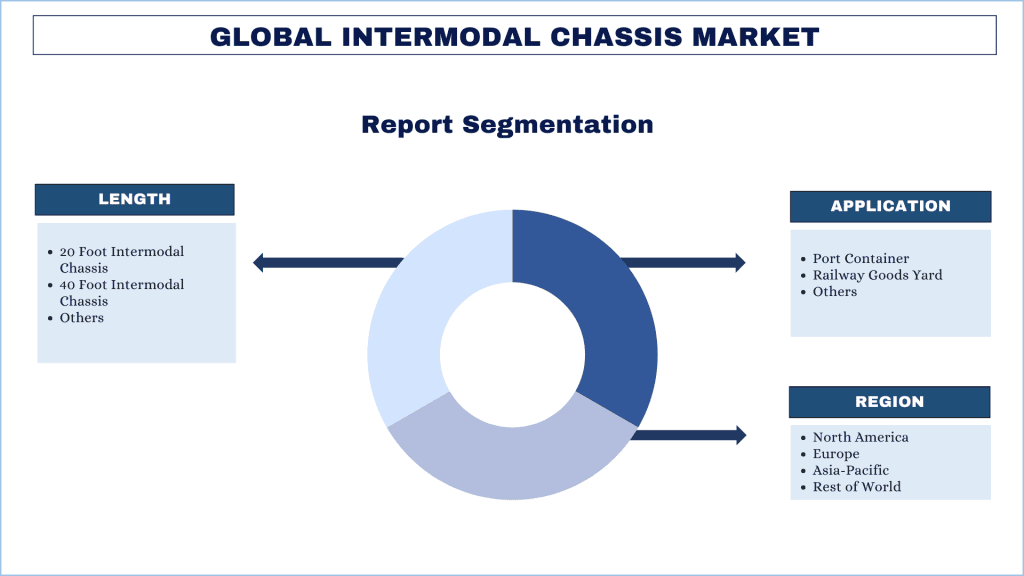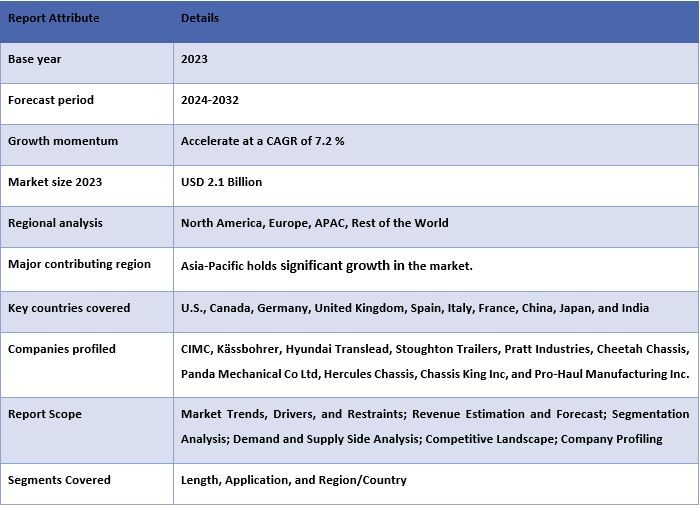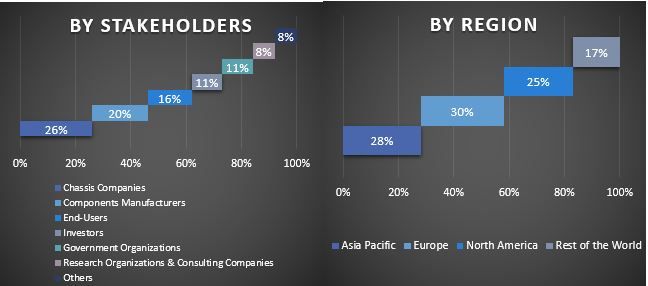- Home
- About Us
- Industry
- Services
- Reading
- Contact Us
Intermodal Chassis Market: Current Analysis and Forecast (2024-2032)
Emphasis on Length (20 Foot Intermodal Chassis, 40 Foot Intermodal Chassis, and Others), Application (Port Container, Railway Goods Yard, and Others), and Region/Country
 Intermodal Chassis Market Size & Forecast
Intermodal Chassis Market Size & Forecast
The Intermodal Chassis Market was valued at USD 2.1 Billion in 2023 and is expected to grow at a robust CAGR of around 7.2 % during the forecast period (2024-2032).
Intermodal Chassis Market Analysis
The intermodal chassis market is experiencing robust growth driven by the increasing adoption of intermodal transportation solutions, which offer significant efficiency and cost advantages over traditional freight methods. Intermodal chassis are critical components in the logistics chain, facilitating the seamless transfer of containers between different transportation modes such as trucks, trains, and ships. This market is witnessing heightened demand due to the expansion of global trade, the growth of e-commerce, and the need for more efficient and sustainable transportation solutions.
Intermodal Chassis Market Trends
The rising emphasis on reducing carbon emissions and improving fuel efficiency in freight transport is propelling the adoption of intermodal transportation, thereby boosting the demand for intermodal chassis. Additionally, technological advancements in chassis design and materials are enhancing their durability and operational efficiency, making them more attractive to logistics companies. The increasing investments in port infrastructure and the expansion of railway networks in key regions are also driving market growth.
The 20-foot intermodal chassis segment is a significant part of the intermodal chassis market, catering to the transportation needs of smaller shipping containers. These chassis are specifically designed to accommodate 20-foot containers, which are commonly used for transporting a variety of goods, including consumer goods, electronics, and machinery. The demand for 20-foot intermodal chassis is driven by factors such as the increasing globalization of trade, the rise of e-commerce, and the need for efficient and cost-effective transportation solutions. In recent years, there has been a focus on improving the efficiency and reliability of 20-foot intermodal chassis, leading to investments in technology and infrastructure.

Asia Pacific is expected to Grow with a Significant CAGR During the Forecast Period.
The Asia Pacific intermodal chassis market is experiencing robust growth driven by rapid industrialization, urbanization, and the expansion of international trade routes. The region’s burgeoning e-commerce sector and increasing investments in port infrastructure and railway networks further bolster this growth. Countries such as China, India, and Japan are at the forefront, leveraging their strategic geographical positions to enhance logistics and transportation efficiencies. The demand for intermodal chassis in these countries is significantly fueled by the need to improve supply chain capabilities and reduce transportation costs
Intermodal Chassis Industry Overview
The intermodal chassis market is competitive and fragmented, with several global and international market players. The key players are adopting different growth strategies to enhance their market presence, such as partnerships, agreements, collaborations, new product launches, geographical expansions, and mergers and acquisitions. Some of the major players operating in the market are CIMC, Kässbohrer, Hyundai Translead, Stoughton Trailers, Pratt Industries, Cheetah Chassis, Panda Mechanical Co Ltd, Hercules Chassis, Chassis King Inc, and Pro-Haul Manufacturing Inc.

Intermodal Chassis Market News
In November 2023, J.B. Hunt Transport Services Inc. and BNSF Railway launched Quantum, a breakthrough intermodal service aimed at enhancing the efficiency and reliability of transporting service-sensitive highway freight using rail. This service offers up to 95% on-time delivery and aims to reduce carbon emissions significantly by converting highway freight to rail intermodal
Intermodal Chassis Market Report Coverage

Reasons to buy this report:
- The study includes market sizing and forecasting analysis validated by authenticated key industry experts.
- The report briefly reviews overall industry performance at one glance.
- The report covers an in-depth analysis of prominent industry peers with a primary focus on key business financials, product portfolios, expansion strategies, and recent developments.
- Detailed examination of drivers, restraints, key trends, and opportunities prevailing in the industry.
- The study comprehensively covers the market across different segments.
- Deep dive regional level analysis of the industry.
Customization Options:
The global intermodal chassis market can further be customized as per the requirement or any other market segment. Besides this, UMI understands that you may have your own business needs, hence feel free to connect with us to get a report that completely suits your requirements.
Table of Content
Research Methodology for the Intermodal Chassis Market Analysis (2024-2032)
Analyzing the historical market, estimating the current market, and forecasting the future market of the global intermodal chassis market were the three major steps undertaken to create and analyze the adoption of intermodal chassis in major regions globally. Exhaustive secondary research was conducted to collect the historical market numbers and estimate the current market size. Secondly, to validate these insights, numerous findings and assumptions were taken into consideration. Moreover, exhaustive primary interviews were also conducted, with industry experts across the value chain of the global intermodal chassis market. Post assumption and validation of market numbers through primary interviews, we employed a top-down/bottom-up approach to forecasting the complete market size. Thereafter, market breakdown and data triangulation methods were adopted to estimate and analyze the market size of segments and sub-segments of the industry. Detailed methodology is explained below:
Analysis of Historical Market Size
Step 1: In-Depth Study of Secondary Sources:
A detailed secondary study was conducted to obtain the historical market size of the intermodal chassis market through company internal sources such as annual reports and financial statements, performance presentations, press releases, etc., and external sources including journals, news and articles, government publications, competitor publications, sector reports, third-party databases, and other credible publications.
Step 2: Market Segmentation:
After obtaining the historical market size of the intermodal chassis market, we conducted a detailed secondary analysis to gather historical market insights and share for different segments & sub-segments for major regions. Major segments are included in the report as length and application. Further country-level analyses were conducted to evaluate the overall adoption of testing models in that region.
Step 3: Factor Analysis:
After acquiring the historical market size of different segments and sub-segments, we conducted a detailed factor analysis to estimate the current market size of the intermodal chassis market. Further, we conducted factor analysis using dependent and independent variables such as length and application of the intermodal chassis market. A thorough analysis was conducted for demand and supply-side scenarios considering top partnerships, mergers and acquisitions, business expansion, and product launches in the global intermodal chassis market sector.
Current Market Size Estimate & Forecast
Current Market Sizing: Based on actionable insights from the above 3 steps, we arrived at the current market size, key players in the global intermodal chassis market, and market shares of the segments. All the required percentage shares split, and market breakdowns were determined using the above-mentioned secondary approach and were verified through primary interviews.
Estimation & Forecasting: For market estimation and forecast, weights were assigned to different factors including drivers & trends, restraints, and opportunities available for the stakeholders. After analyzing these factors, relevant forecasting techniques i.e., the top-down/bottom-up approach were applied to arrive at the market forecast for 2032 for different segments and sub-segments across the major markets globally. The research methodology adopted to estimate the market size encompasses:
- The industry’s market size, in terms of revenue (USD) and the adoption rate of the intermodal chassis market across the major markets domestically.
- All percentage shares, splits, and breakdowns of market segments and sub-segments
- Key players in the global intermodal chassis market in terms of products offered. Also, the growth strategies adopted by these players to compete in the fast-growing market.
Market Size and Share Validation
Primary Research: In-depth interviews were conducted with the Key Opinion Leaders (KOLs) including Top Level Executives (CXO/VPs, Sales Head, Marketing Head, Operational Head, Regional Head, Country Head, etc.) across major regions. Primary research findings were then summarized, and statistical analysis was performed to prove the stated hypothesis. Inputs from primary research were consolidated with secondary findings, hence turning information into actionable insights.
Split of Primary Participants in Different Regions

Market Engineering
The data triangulation technique was employed to complete the overall market estimation and to arrive at precise statistical numbers for each segment and sub-segment of the global intermodal chassis market. Data was split into several segments & sub-segments after studying various parameters and trends in the length and application of the global intermodal chassis market.
The main objective of the Global Intermodal Chassis Market Study
The current & future market trends of the global intermodal chassis market were pinpointed in the study. Investors can gain strategic insights to base their discretion for investments on the qualitative and quantitative analysis performed in the study. Current and future market trends determined the market’s overall attractiveness at a regional level, providing a platform for the industrial participant to exploit the untapped market to benefit from a first-mover advantage. Other quantitative goals of the studies include:
- Analyze the current and forecast market size of the intermodal chassis market in terms of value (USD) and the current and forecast market size of different segments and sub-segments.
- Segments in the study include areas of length and application.
- Define and analyze the regulatory framework for the intermodal chassis
- Analyze the value chain involved with the presence of various intermediaries, along with analyzing customer and competitor behaviors of the industry.
- Analyze the current and forecast market size of the intermodal chassis market for the major region.
- Major countries of regions studied in the report include Asia Pacific, Europe, North America, and the Rest of the World
- Company profiles of the intermodal chassis market and the growth strategies adopted by the market players to sustain in the fast-growing market.
- Deep dive regional level analysis of the industry.
Frequently Asked Questions FAQs
Q1: What is the intermodal chassis market's current market size and growth potential?
Q2: What are the driving factors for the growth of the intermodal chassis market?
Q3: Which segment has the largest intermodal chassis market share by application?
Q4: What are the emerging technologies and trends in the intermodal chassis market?
Q5: Which region will dominate the intermodal chassis market?
Related Reports
Customers who bought this item also bought










